Lettuce Farming
Lettuce is a leafy green vegetable commonly grown for its crisp, tender leaves. It thrives in cool climates and is widely used in salads and sandwiches. Lettuce grows quickly, requires consistent moisture, and is sensitive to heat, which can cause bitterness and bolting.
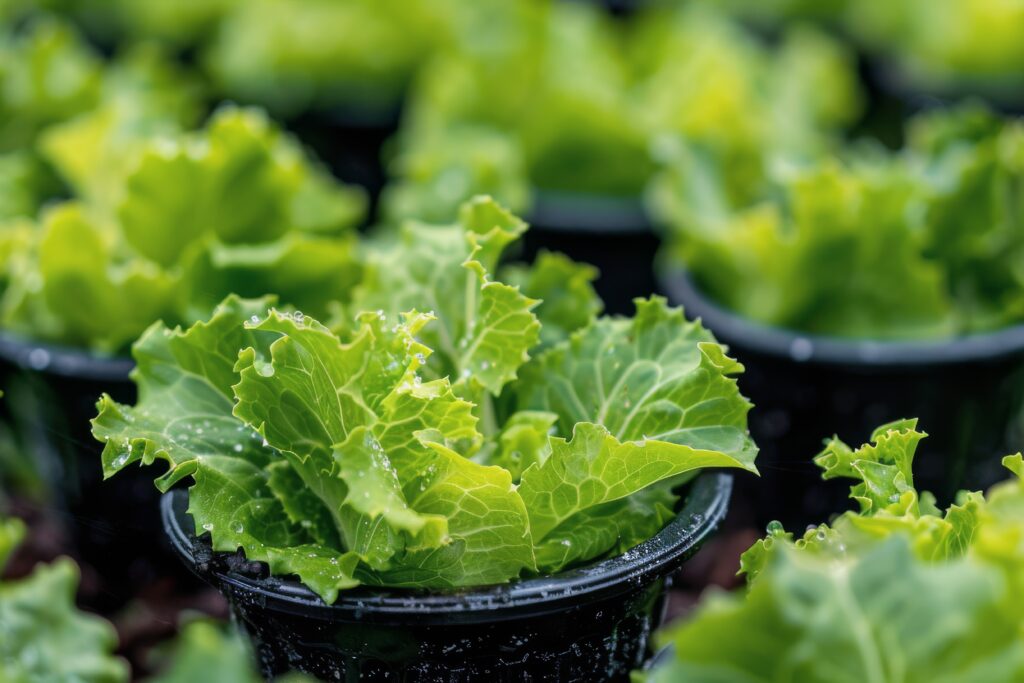
Lettuce farming profit per acre demonstrates strong financial viability, as evidenced by a detailed profitability analysis showing a gross income of NRs 200,000 generated from a yield of 10,000 kg sold at NRs 20 per kg, against a total investment cost of NRs 50,000 covering all operational expenses from land preparation to harvesting.
This results in a substantial net profit of NRs 150,000 per acre, reflecting an exceptional 75% profit margin and a 300% return on investment (ROI), confirming it as a highly profitable and efficient agricultural venture with significant income-generating potential for farmers.
Land Preparation
Lettuce farming profit per acre begins with thorough land preparation aimed at creating a fine, level, and weed-free seedbed with good tilth to ensure uniform seed germination or successful transplanting and efficient water management.
The process involves deep plowing (8–10 inches) to break up hardpan and incorporate crop residues, followed by repeated harrowing or rotavation to break clods. Leveling is essential for even water distribution, particularly under furrow or flood irrigation, as it helps prevent waterlogging in low areas.
Raised beds, typically 4–6 inches high and 3–4 feet wide, are commonly formed to improve drainage, soil warming, root aeration, and harvesting efficiency, with precise shaping to maintain consistency. Finally, a smoothing pass with a float or light harrow creates a uniform, fine surface, ensuring the removal of large stones and debris for optimal crop establishment.
Soil Type
The ideal soil for lettuce farming is a well-drained, loamy type—such as sandy loam, silt loam, or clay loam—rich in organic matter, with a slightly acidic to neutral pH of 6.0–7.0. Soils below pH 5.5 risk aluminum and manganese toxicity, while those above 7.0 can lead to micronutrient deficiencies, particularly in iron and manganese.
Good drainage is critical because lettuce has shallow roots and is highly vulnerable to root rots in waterlogged conditions, making heavy, poorly drained clays unsuitable. A high organic matter content of over 2.5% enhances water retention, drainage, nutrient availability, and overall soil structure, supporting healthy crop growth.
Climatic Requirements
Temperature Requirements
- Optimal growth
Lettuce is fundamentally a cool-season crop with specific temperature needs. For optimal growth and leaf development, maintain temperatures between 15°C – 20°C (59°F – 68°F). Germination occurs within 4°C – 27°C (39°F – 81°F), but the ideal range is 18°C – 22°C (65°F – 72°F) for rapid, uniform sprouting.
- Bolting Sensitivity
Premature flowering (bolting) is triggered when temperatures consistently exceed 24°C (75°F), especially under long daylight hours. Bolting renders leaves bitter and tough. In warmer seasons, mitigate this by selecting heat-tolerant cultivars bred for bolt resistance.
- Frost Tolerance
Young lettuce seedlings can withstand light frosts, but mature heads are vulnerable. Hard frosts below -2°C (28°F) damage head integrity and marketability. Timely harvesting before severe frosts is critical in cold climates.
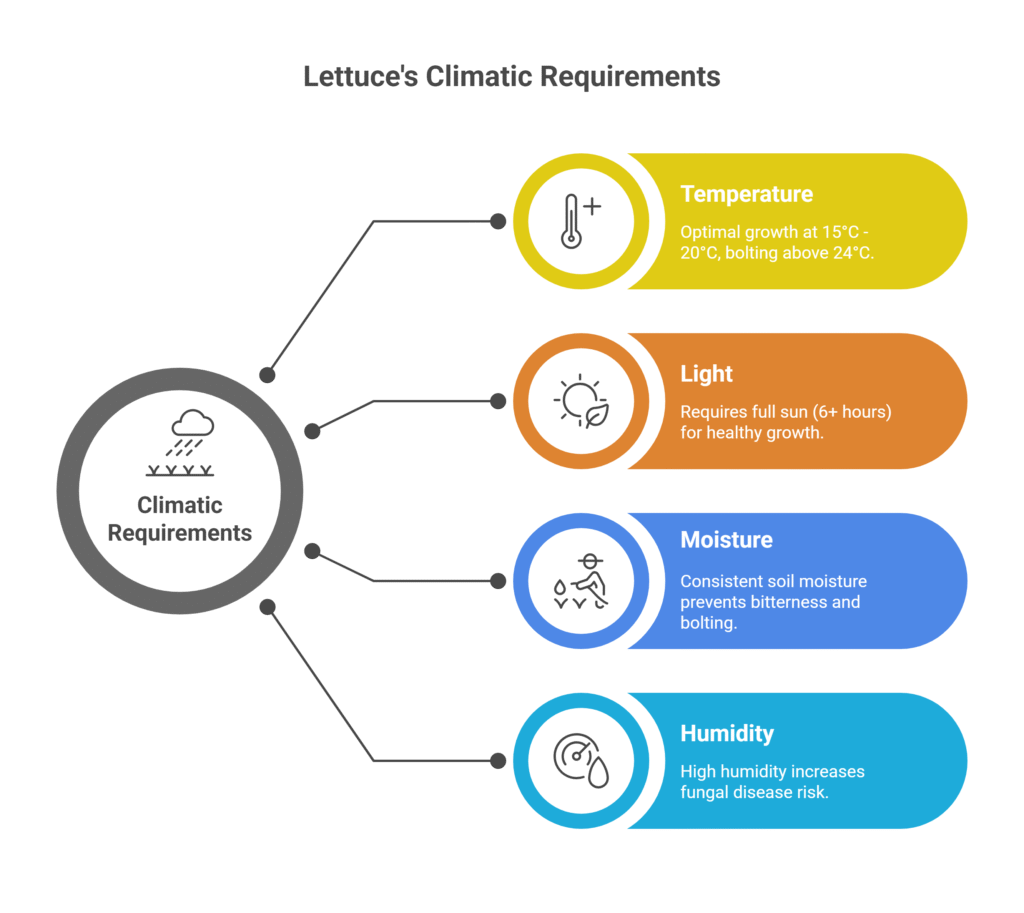
Light Requirements
Lettuce thrives in full sun (6+ hours daily). Insufficient light causes weak, elongated plants with loose heads. Note that long photoperiods (day lengths) combined with heat accelerate bolting, requiring careful seasonal planning.
Moisture Management
Consistent soil moisture is non-negotiable. Drought stress induces bitterness, stunted growth, and premature bolting. However, high humidity exacerbates fungal diseases (e.g., downy mildew). Balance irrigation to keep roots moist without waterlogging foliage or soil.
Humidity & Disease Risk
While adequate moisture supports growth, elevated humidity creates ideal conditions for pathogens. Ensure good airflow via proper spacing and avoid overhead irrigation in humid regions to reduce fungal disease pressure.
Major Cultivars (Types)
Lettuce variety selection depends on factors such as market demand, seasonal suitability including heat or cold tolerance and bolt resistance, disease resistance, uniformity in growth and appearance, and good shelf life to ensure marketability and profitability.
| Cultivar Type | Head/Leaf Description | Texture & Flavor | Growth Characteristics | Key Features | Example Varieties |
| Crisphead (Iceberg) | Tight, firm, spherical heads | Crispy texture, mild flavor | Demanding to grow, requires precise conditions | Longest shelf life | ‘Great Lakes’, ‘Salinas’, ‘Ithaca’ |
| Butterhead (Bibb/Boston) | Loose, soft heads with tender leaves | Buttery texture, mild sweet flavor | Less heat tolerant than other types | – | ‘Buttercrunch’, ‘Boston’, ‘Bibb’ |
| Romaine (Cos) | Tall, cylindrical heads with stiff upright leaves | Crisp rib, robust flavor | Tolerates heat better than crisphead | – | ‘Parris Island Cos’, ‘Valmaine’, ‘Jericho’ |
| Leaf Lettuce | Non-heading loose rosettes | Varies by variety | Fastest maturing type | Wide color/leaf variation; Cut-and-come-again harvest | ‘Black Seeded Simpson’, ‘Oakleaf’, ‘Red Sails’, ‘Lollo Rosso’ |
Propagation
Lettuce is propagated exclusively through seeds, using either direct seeding or transplanting methods. In direct seeding, seeds are sown directly into well-prepared field beds, a common practice for leaf lettuce and baby leaf production, requiring precise depth control for uniform germination.
Transplanting involves sowing seeds into trays—such as plug trays or cell packs—in a greenhouse or protected nursery, where seedlings are grown for 3–5 weeks until they develop 3–5 true leaves before being moved to the field. This method, preferred for head lettuce, ensures better spacing, uniformity, earlier harvest, more efficient land use, and reduced risks associated with poor field germination.
Seed Rate per Acre
The recommended seed rate per acre is 200 – 250 grams when raising seedlings for transplanting, while direct seeding requires 400–600 grams per acre, with thinning necessary to achieve optimal plant spacing.
Nursery Management
For effective nursery management, prepare a seedbed 1 meter wide and of suitable length, making 2 cm deep drills spaced 10–15 cm apart.
Sow seeds thinly, cover lightly with soil, and apply mulch to protect the seedlings. Water regularly without over-watering to avoid damping-off disease and begin hardening seedlings 1–2 weeks before transplanting by gradually reducing watering and shade. Raising seedlings in pots can also help prevent overgrowth in the nursery.
Prepare the nursery bed between mid-September and mid-November, as seeds typically germinate within 3–4 days. After emergence, ensure seedlings receive at least 3–4 hours of direct morning sunlight daily to promote healthy growth. When the seedlings reach 4–6 weeks old, transplant them into the main field for continued development.
Planting
a). Planting Season
The planting season for lettuce typically spans from September to November.
b). Spacing
The common spacing for lettuce planting is 60 cm between rows and 40 cm between plants within each row.
c). Planting Method
Direct Seeding
When direct seeding, use precision seeders to achieve uniform planting depth (0.3–1.0 cm or 1/8–1/2 inch) and correct spacing. Post-sowing, apply a thin covering of fine soil or vermiculite over the seeds to aid even germination. It’s crucial to keep soil moisture steady throughout germination to encourage vigorous seedling development.
Transplanting
For transplanting, select a cool, still day—ideally late afternoon—to reduce stress on seedlings. Thoroughly water them while still in their trays. Place each transplant at the same depth it was growing previously, gently tamping the soil around the roots for support. Water right after planting to help the plants settle in quickly.
d). Number of Plants per Acre
With a standard spacing of 60 cm × 40 cm, an acre can hold about 16,862 plants.
Intercropping
Lettuce can be successfully intercropped with slower-maturing crops such as tomatoes, peppers, corn, or brassicas like cabbage and broccoli. This practice offers several benefits, including more efficient land use, weed suppression through the lettuce canopy, and potential pest deterrence due to increased crop diversity.
However, it is important to provide adequate spacing and light for all crops, prevent competition for water and nutrients, and coordinate harvest schedules since lettuce matures quickly. Intercropping is generally better suited for small-scale or diversified farming rather than large-scale monoculture production.
Irrigation
Due to its short root structure, lettuce needs constant soil moisture without becoming saturated because water stress can cause tipburn, bolting, and bitterness. Although they are good for chilling plants and germination, overhead sprinklers use more water and raise the risk of foliar diseases.
On level or slightly elevated fields, furrow irrigation is frequently used in row systems; however, it must be carefully managed to avoid waterlogging. The most effective and recommended technique is drip or trickle irrigation, which provides water directly to the root zone, reduces leaf wetness, conserves water, and permits fertigation—perfect for raised beds in particular.
Especially with drip systems, irrigation should be moderate and frequent. It should also be regulated by the weather, soil type, and development stage, with the highest demand occurring during head formation to prevent wilting.
Fertilizer and Manure
Nutrient Demand
This crop is a moderate to heavy feeder, requiring significant amounts of Nitrogen (N) and Potassium (K). Adequate Phosphorus (P) is essential at the time of planting.
Soil Testing
Farmers must conduct a soil test before planting to identify existing nutrient levels. This enables accurate, tailored fertilizer recommendations for the field.
Organic Matter Application
Incorporate 10-15 tons per acre of well-decomposed compost or manure before planting. This improves soil structure and provides slow-release nutrients. Avoid fresh manure close to harvest due to pathogen risks.
Basal Fertilization
During final bed preparation, apply a balanced NPK fertilizer (e.g., 20-20-20) and mix it thoroughly into the topsoil. This serves as the primary nutrient foundation.
Supplemental Feeding (Top/Side Dressing)
Apply additional nitrogen fertilizer, such as Calcium Nitrate or Ammonium Sulfate, at a rate of 20–27 kg of nitrogen per acre about 2–4 weeks after transplanting or thinning. A second application at the same rate may be needed when the lettuce heads start to promote healthy growth.
Nitrogen Management Caution
Avoid excessive Nitrogen application. Too much N can lead to soft heads, tip burn (leaf edge damage), and reduced post-harvest shelf life.
Weed Control
Effective weed management is critical in lettuce production, as weeds aggressively compete for light, water, and nutrients, harbor pests and diseases, and impede harvest. Employ an integrated approach starting with cultural methods like preparing a clean seedbed, implementing crop rotation, and using precise irrigation (avoiding unnecessary wetting of entire bed surfaces).
Mechanical control includes shallow cultivation (hoeing) between rows before weeds establish and careful hand weeding within rows; flame weeding can be used for pre-emergence control in direct-seeded crops.
For chemical control, apply pre-emergent herbicides immediately after planting or transplanting, strictly following the product label’s crop-specific instructions and dosage rates (400 – 600g/acre for common herbicides like Pendimethalin, but ALWAYS verify the label). Note that post-emergent herbicide options are extremely limited due to lettuce’s high sensitivity; their use requires expert selection and precise application to avoid crop damage.
Mulching with organic materials (e.g., straw at 4-6 tons/ha) or plastic film is highly effective for suppressing weeds, conserving moisture, and moderating soil temperature, with plastic mulch being common in intensive systems.
Flowering and Fruit Management
Lettuce is cultivated for its vegetative leaves, so bolting—the formation of flower stalks—is undesirable because it causes leaves to become bitter and tough. To manage bolting, choose slow-bolting varieties suited to the season, maintain cool temperatures and consistent moisture, and avoid stress factors such as drought or nutrient deficiencies. Harvest the crop promptly at maturity, and if bolting begins, harvest immediately while the leaves are still marketable.
Pest and Disease Management
Common Pests
Aphids
These small sap-sucking pests transmit viruses and contaminate lettuce heads. Control starts with insecticidal soaps (2-3% solution) or neem oil (0.5-2% solution). Introduce biological agents like ladybugs for sustainable management. For severe infestations, apply selective insecticides like acetamiprid (20% SP at 50–60 g/acre) or imidacloprid (0.5 ml/L spray), ensuring application before head formation.
Cutworms
Cutworms sever seedlings at the soil line overnight. Prevent damage using physical barriers (transplant collars) or bait formulations. At planting, apply chlorpyrifos (20% EC at 2.5–3 L/acre in soil) or cypermethrin (250 g/ha foliar spray) during evening hours for maximum efficacy.
Leaf Miners
Larvae create unsightly tunnels inside leaves, reducing marketability. Monitor adults with yellow sticky traps and remove infested leaves promptly. Apply spinosad (45% SC at 0.5–1 ml/L spray), targeting the underside of leaves. Repeat every 7–10 days if needed.
Slugs and Snails
These nocturnal pests chew irregular holes in leaves, thriving in moist conditions. Use beer traps or diatomaceous earth barriers. Apply metaldehyde baits (5–10 kg/ha) or iron phosphate pellets (6% bait at 10–15 kg/ha) in evening, avoiding contact with lettuce heads.
Whiteflies
Whiteflies cause yellowing, transmit viruses, and promote sooty mold. Deploy yellow sticky traps for monitoring and suppression. Treat with neem oil (1% solution) or insecticidal soap. For heavy infestations, use buprofezin (25% SC at 1.5–2 ml/L) or pyriproxyfen (10% EC at 500 ml/ha). Release Encarsia wasps for biocontrol.
Armyworms/Cabbage Loopers
Caterpillars chew large holes in foliage. Apply Bt (Bacillus thuringiensis var. kurstaki, 5% WP at 1–2 g/L) for organic control. For rapid knockdown, use spinosad (45% SC at 1 ml/L) or emamectin benzoate (5% SG at 200 g/ha). Target young larvae for best results.
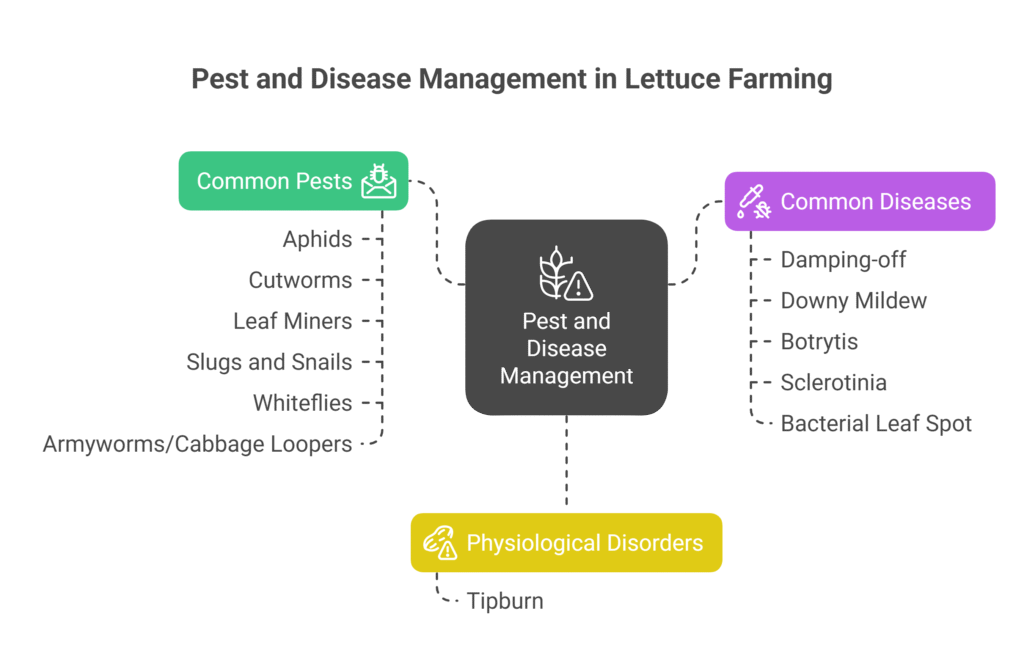
Common Diseases
Damping-off (Pythium, Rhizoctonia, Fusarium)
Causes seedling collapse pre- or post-emergence. Prevent sterile potting media, optimal drainage, and avoiding overwatering. Apply seed treatments: Metalaxyl (2g/kg seed) for Pythium or Thiram (3g/kg seed) for Fusarium/Rhizoctonia. For soil drench post-emergence, use Metalaxyl-M (4% AS) at 2.5 mL/L water or Azoxystrobin (23% SC) at 1.5 mL/L.
Downy Mildew (Bremia lactucae)
Identified by yellow angular leaf spots and white fungal growth undersides. Use resistant varieties, ensure air circulation, and avoid overhead irrigation. Apply fungicides Mandipropamid (23.4% SC) at 0.4 mL/L, Amisulbrom (20% SC) at 2.5 mL/L, or Fosetyl-Al (80% WP) at 2.5 g/L. Rotate FRAC groups to prevent resistance.
Botrytis (Gray Mold)
Manifests as fuzzy gray mold on damaged/aging tissue. Manage via sanitation, airflow improvement, and minimizing plant wounds. Apply Iprodione (50% WP) at 2 g/L, Cyprodinil + Fludioxonil (37.5% WG) at 0.6 g/L, or Boscalid (26.7% SC) at 1.5 mL/L. Target base of plants and dense foliage.
Sclerotinia (Lettuce Drop)
Causes wilting, white mold, and black sclerotia at stem base. Rotate with non-hosts (3+ years) and improve drainage. At transplanting, apply soil drench: Fluazinam (50% SC) at 0.5 mL/L or foliar spray: Iprodione (50% WP) at 2 g/L. Repeat mid-season if conditions favor disease.
Bacterial Leaf Spot (Xanthomonas, Pseudomonas)
Water-soaked lesions turning necrotic. Use certified disease-free seed and drip irrigation. Copper sprays offer limited suppression: Copper hydroxide (77% WP) at 2 g/L or Copper oxychloride (50% WP) at 3 g/L applied every 7–10 days. Note: Efficacy is partial; focus on prevention.
Tipburn (Physiological Disorder)
Marginal leaf necrosis from calcium deficiency during rapid growth. Not fungal; correct with balanced fertilization (ensure soil Ca > 800 ppm) and consistent irrigation. Apply calcium nitrate foliar spray (1–2% solution) during head formation. Select resistant varieties (e.g., ‘Salanova’).
Harvesting
Harvesting lettuce occurs at stages ranging from baby leaf to semi-mature or full head, dictated by market demand. For head varieties (Crisphead, Romaine, Butterhead), cut the entire head at its base just above the soil with a sharp knife, typically removing outer wrapper leaves either in the field or later at the packing shed.
Full-size leaf lettuce can be harvested whole by cutting at the base or through multiple harvests using the “cut-and-come-again” method, selectively picking outer leaves. Baby leaf lettuce is harvested by cutting entire plants 1–2 inches above the soil when leaves reach 3–4 inches long, enabling regrowth for subsequent cuts.
Always harvest early in the morning when temperatures are coolest and leaves are crispest, avoiding wet conditions to minimize disease; handle carefully to prevent bruising, placing cut lettuce immediately into field crates and moving it swiftly to shade or cooling facilities.
Yield
Lettuce yield averages around 10,000 kilograms per acre under typical growing conditions.
Cost of Investment per acre of Lettuce Farming
| S.N. | Categories | Cost of Investment (NRs.) |
| 1 | Land Preparation (plowing) | 15,000 |
| 2 | Seed | 1,000 |
| 3 | Nursery Management | 5,000 |
| 4 | Transplanting | 3,000 |
| 5 | Fertilizers and Manure | 8,000 |
| 6 | Irrigation | 3,000 |
| 7 | Weed Control (pre & post-emergence) | 2,000 |
| 8 | Pest & Disease Control | 3,000 |
| 9 | Harvesting | 5,000 |
| 10 | Miscellaneous Costs | 5,000 |
| Total Cost | 50,000 |
Income per acre from Lettuce Farming
| Particulars | Estimated Yield / Acre (Kg) | Market Price (NRs/kg) | Total Income (NRs.) |
| Yield | 10,000 | 20 | 200,000 |
Analysis of Lettuce Farming Profit Per Acre
The profitability analysis of lettuce farming shows a gross income of NRs 200,000 from 10,000 kg sold at NRs 20 per kg, with a total investment cost of NRs 50,000. This results in a net profit of NRs 150,000, reflecting a profit margin of 75% and a return on investment (ROI) of 300%, indicating a highly profitable venture.
Crop Calendar of Lettuce Farming
| Phase | Timeline | Key Activities & Specifications | Technical Notes |
| Land Prep | Late August | Deep plowing (8-10″), harrowing, leveling. Form raised beds (4-6″ H, 3-4′ W). Incorporate 10-15 tons/acre compost. | Soil pH: 6.0-7.0. Avoid waterlogged soils. Organic matter >2.5%. |
| Nursery | Mid-Sep to Mid-Nov | Sow seeds @ 15-20 cm spacing. Germination (3-4 days). Provide 3-4 hrs morning sun daily. | Seed rate: 200-250g/acre. Protect from heavy rain. Harden seedlings 1 week pre-transplant. |
| Transplanting | 4-6 weeks after sowing | Transplant on cool afternoons. Spacing: 60×40 cm (16,862 plants/acre). Water immediately. | Apply basal fertilizer (62.5kg/acre 20-20-20) during bed prep. |
| Vegetative Growth | Weeks 1-4 | Irrigation: Drip system, keep soil moist. Weed Control: Apply Pendimethalin (400-600g/acre) pre-emergence. Hand-weed as needed. | Critical temp: 15-20°C. >24°C risks bolting. Mulch (@4-6 tons/ha) recommended. |
| Head Formation | Weeks 5-6 | Top-dressing: Apply 20-27kg N/acre (e.g., Calcium Nitrate). Pest/Disease Control: Monitor aphids/whiteflies; use Spinosad (0.5-1ml/L) if needed. | Avoid overhead irrigation. Check for downy mildew (prevent with Mandipropamid @0.4ml/L). |
| Pre-Harvest | Week 7 | Reduce irrigation 3 days pre-harvest. Scout for tipburn (apply CaNO₃ foliar if needed). | Night temps <10°C reduce bitterness. |
| Harvest | Week 8-10 | Harvest at dawn. Head types: Cut base, trim wrappers. Leaf types: “Cut-and-come-again” @1-2″ height. | Yield: 10,000kg/acre. Immediate cooling (<5°C) preserves quality. |
Sources
Food and Agriculture Organization (FAO)
University of California Agriculture & Natural Resources (UC ANR)
European Plant Protection Organization (EPPO)
Punjab Agricultural University (PAU)
Tamil Nadu Agriculture University (TNAU) – Agritech portal
Indian Council of Agricultural Research (ICAR)
Nepal Agricultural Research Council (NARC)
U.S. Department of Agriculture (USDA).
Disclaimer: This crop farming profits assume optimal conditions. Actual results may vary depending on climate, market prices, and farm management practices.

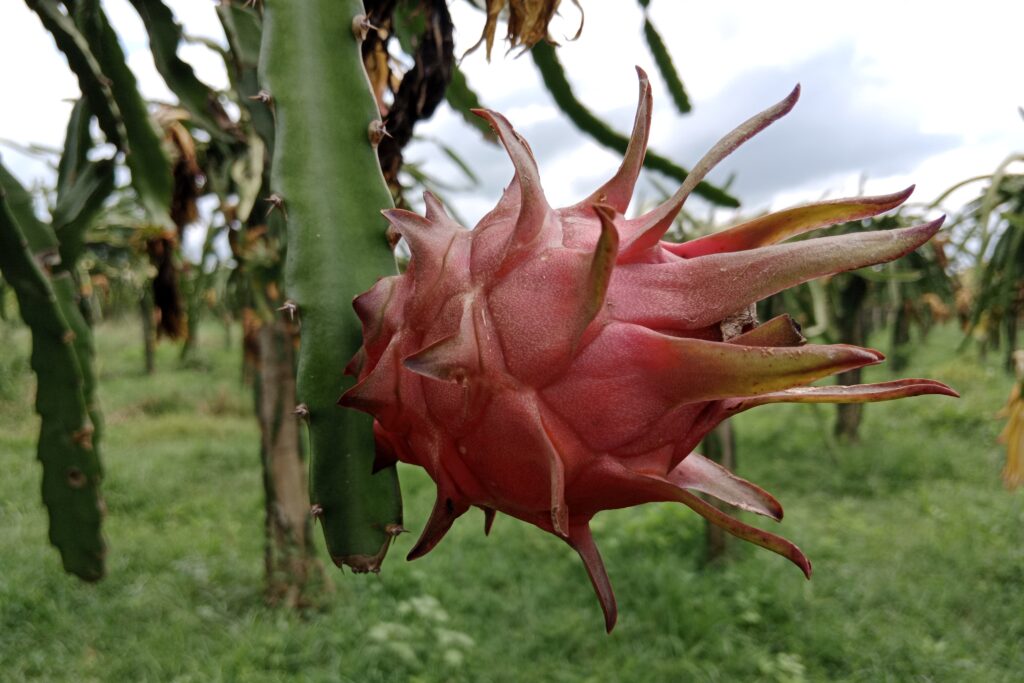
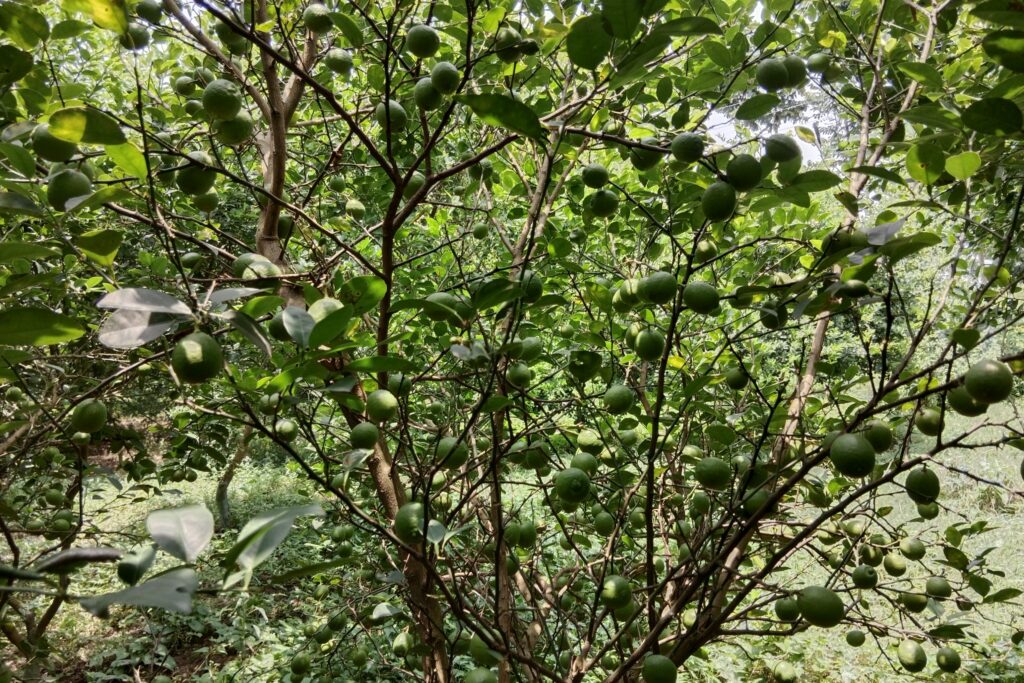
Pingback: Endive Farming Profit Per Acre -
Pingback: Bathua Farming Profit per Acre -